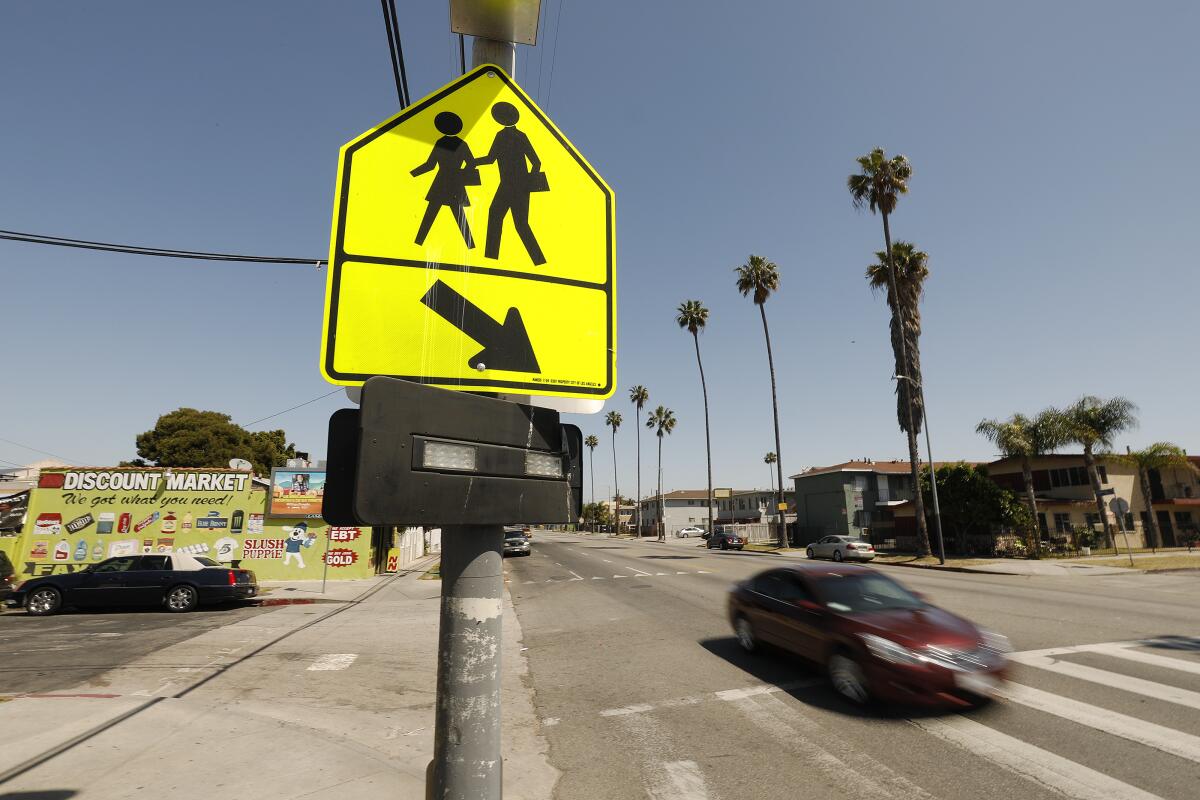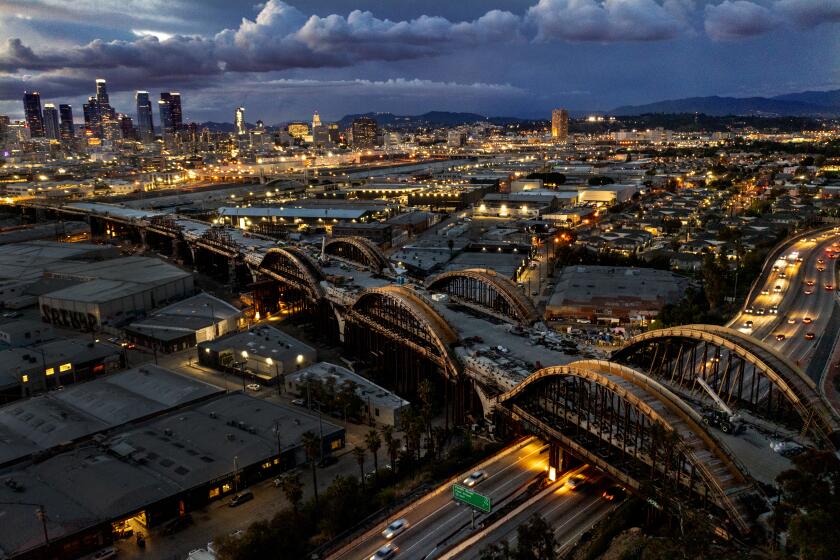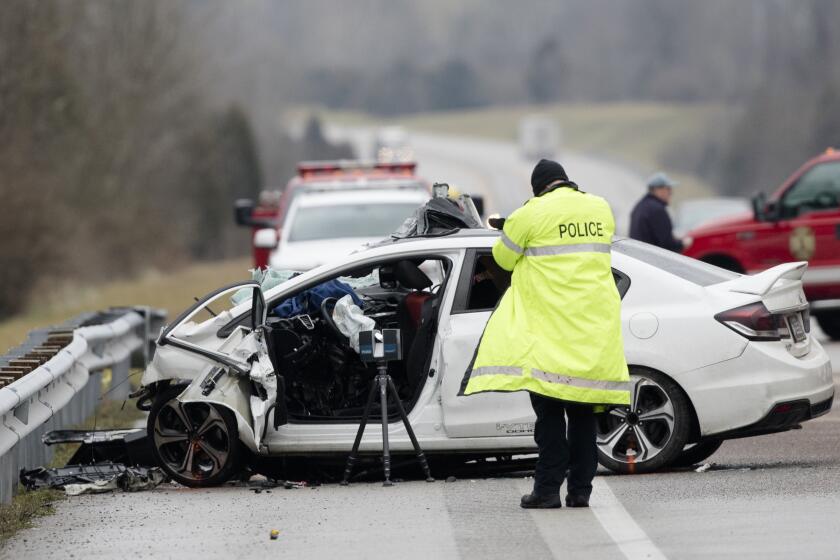No turn signals, no honking: These are the most quintessential L.A. driving habits

- Share via
In summer 2021, we began asking readers to send us their pressing questions about Los Angeles and California.
Every few weeks, we put the questions to a vote, asking readers to decide which question we’ll answer in story form.
Our latest winner was submitted by Felipe Delerme. His question: “Why do drivers in LA refuse to use their turn signal? In any capacity.”
I laughed when I came across Delerme’s question — maybe you’re nodding your head knowingly, too. It’s obviously hyperbolic, but the question has more than a kernel of truth to it. If you spend a day driving around Los Angeles, you’ll probably notice several fellow drivers swooping from lane to lane without a signal.
“What we see happen a lot here in L.A. is that people don’t signal when they change lanes or they signal literally at the very last minute they change lanes, or they don’t even bother to check over the shoulder when there could be another driver next to them,” said Joshua Mendoza, an instructor at Melrose Driving School in Hollywood.
One obvious reason for this habit? “They’re in such a hurry to go from point A to point B,” Mendoza said.
Whatever’s puzzling you about life in L.A. and California, we want to hear about it.
“If you follow the rule from the DMV manual, there’s a set distance from your turn that you should activate your turn signal,” said Daniel Mitchell, the chief engineer for LADOT. “But we know that as soon as you turn on your turn signal to change lanes, all of a sudden, the spot that was there for you disappears, because the person behind accelerates when they see your turn signal.”
“I have three boys who are driving age, and as I have taught them, while changing lanes, you only turn on your turn signal when you already know what you’re going to do so that you can communicate that to other people,” he continued.
But bending the rules when it comes to turn signals isn’t the only L.A. driving habit, is it?
We asked via Twitter about other L.A. driving idiosyncrasies, and received, well, a variety of responses.
But before I go any further: This story is absolutely not an endorsement of reckless driving behaviors, which put people’s lives at risk. Fatal car crashes happen all the time. Please be safe out there.
“Driving slow in the fast lane is the s—,” said one Twitter user. (I see this fairly often, but my editor, who is from Miami, disagrees and says this habit is way more “Florida” than “California.”)
“If you‘re suddenly caught in the middle of a televised car chase, make sure you text a friend so they can record you on the news,” another replied. (Yes, car chases on TV are unfortunately very L.A., as is texting and driving — but please don’t do either.)
“Tailgate even when there’s no traffic,” one respondent said.
Abraham Polanco, co-owner of A1 Driving and Traffic School near Culver City, agreed that tailgating happens frequently in L.A. “I think I see more tailgating, or driving too close to the car in front of you, more now than I have before,” he said.
One of the most quintessential L.A. driving habits: When you’re at a busy intersection, and cars are lining up to turn left, you’ll usually see a couple of cars seize the intersection and turn after the light turns red.
Mendoza says he’s noticed more and more drivers doing this over the past year. “I’ve seen at an intersection literally three cars, maybe even four cars” try to make the left turn after the light turns red, he said.
L.A. Times readers are curious about weather, wildfire and relics of the Cold War, among other things.
Why all the left-turn risk-taking? Polanco suggests it could be the lack of protected left turns in many L.A. intersections. “You don’t have as many protected left turns as you do in the suburbs,” said Polanco, who lives in Orange County. “That’s why you’ll have some aggressive driving.”
Rolling stops are another driving practice Mendoza notices frequently. “Everyone knows you’re supposed to make a complete stop at a stop sign or red light,” he said. “But a lot of drivers don’t really come to a complete stop.”
At an intersection, “you’ll see people literally stop in the middle of the crosswalk, even if there’s a pedestrian walking towards them, because they really want to make that turn as fast as they can,” Mendoza said.
From his perspective, “that’s the number one thing L.A. drivers need to fix.”
There seems to be a theme here: L.A. drivers are in a hurry, due in part to the time they spend sitting in traffic. They try to make up this time by bending the rules of the road to expedite their journey.
It makes sense; after all, who hasn’t sped through a yellow light while running late to work? Lots of Angelenos are juggling multiple jobs and time-consuming family responsibilities while trying to navigate the headaches of driving in L.A. While the city’s overwhelming traffic doesn’t make driving violations any less dangerous, it does help explain them.
On a positive note, Mendoza says he notices L.A. drivers show more consideration toward children, the elderly and other vulnerable members of society compared to drivers in other cities. “People 100% have the utmost respect for whenever they see kids walking across crosswalks or sidewalks or driving by school zones,” he said.
Another good traffic habit, according to Mendoza: “People are definitely more reluctant to use their horns” compared to drivers in other cities.
However, drivers still have a long way to go when it comes to interacting with cyclists on the road, Mendoza said. “What still needs improvement with a lot of L.A. drivers is, when they’re ready to make a right turn at an intersection, they don’t bother to check their blind spots or their side mirror.”
In cases like this, a driver could cut off a cyclist pedaling near them — or crash directly into the cyclist as they make their turn.
A need for speed is perhaps the most noticeable L.A. driving habit — one that comes at a great cost.
Evidence suggests the pandemic has made U.S. drivers more reckless — more likely to speed, drink or use drugs and to leave their seatbelts unbuckled.
Even people who intend to follow the speed limit may find themselves going faster and faster on the road, Mendoza said. Especially during rush hour, “when someone’s not keeping up, that’s when [other drivers] get really annoyed,” he said.
Over the years, Angelenos’ propensity for fast driving has actually resulted in higher speed limits through a process called “speed creep.”
“We set the speed limits by measuring how fast drivers travel, and then use that to guide how we set the speed limit,” said Mitchell. Speed creep is “the idea that over time people are traveling a little bit above the posted limit…then, [after conducting the required speed surveys], we bring the speed limit up and they go a little faster.”
The cycle continued, with speed limits rising higher and higher and people driving faster and faster. (Now, with the approval of Assembly Bill 43, the speed creep cycle is coming to an end, Mitchell said. Prior to its passage, L.A. was required to raise the speed limit based on the results of speed surveys in order to enforce the posted speed limit.)
The consequences for speeding can be dire. “When drivers are traveling faster, that makes the impact of crashes much more severe, and that’s what causes people to become seriously injured or killed,” Mitchell said. “We’ve had a dramatic increase in the number of people severely injured and killed in this last year.”
Traffic collisions killed 294 people in L.A. last year, city officials said, a substantial jump from 2020.
Mitchell encourages L.A. drivers to think about driving the same way they think about operating a shopping cart.
“As you’re walking into the grocery store, you wouldn’t try and shove your way past someone, you would be courteous and thoughtful, hopefully,” he said. “We ask that people be thoughtful and respectful of others as they’re driving.”
What L.A. driving habits do you notice all the time? Leave a comment below.
Parking in Los Angeles is about luck and skill. So save time and money by learning these hacks with yellow curbs, green curbs, holiday rules, valet and more.
More to Read
Sign up for Essential California
The most important California stories and recommendations in your inbox every morning.
You may occasionally receive promotional content from the Los Angeles Times.


















